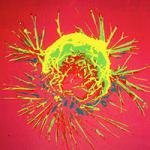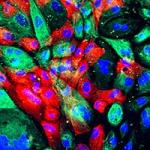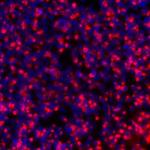
Research Topics
Dr. Brown is fascinated by the primary cilium as a site of integration of key signaling pathways important in both development and disease. Primary cilia are microtubule-based organelles that project from the cell surface in a dynamic fashion and receive and process molecular and mechanical signaling cues. They are ubiquitous having been found on essentially all human cell types. His PhD thesis in the laboratory of Jonathan T. Eggenshwiler, PhD elucidated mechanisms through which the primary cilium regulates responses to sonic hedgehog signaling during mouse embryonic development. He cloned a version of mice depleted for the cell cycle-related kinase (CCRK) or CDK20 protein. As anticipated, CCRK is embryonic lethal–clear evidence for the critical requirement for this protein during development. Ultimately, the lab demonstrated that CCRK positively regulates the kinetics by which ciliary proteins such as smoothened (SMO) and Gli2 are imported into the primary cilium thus facilitating potent responses to Hedgehog signaling over long time periods (Snouffer, Brown et al. 2017). It is now known that CCRK is actively transcribed and overexpressed in at least 17 types of human cancers including virtually all glioblastomas (GBMs). In the context of cancer, CCRK represents an important (and novel) signaling hub, integrating critical cancer phenotypes. A non-exhaustive list of cancer phenotypes related to CCRK include increased proliferation, chemotherapy resistance, invasiveness and immunosuppression. The role of the primary cilium in cancer molecular biology remains critically underexplored and this is an area Dr. Brown continues to investigate with the goal of translating novel therapies to the clinic.
Biography
Dr. Brown is an ACI in the Surgical Neurology Branch. He received a combined MD/PhD degree in 2014 from the combined Rutgers RWJ/Princeton University combined MD/PhD program. He then completed residency in neurological surgery with a fellowship in neurosurgical oncology at the Mayo Clinic in 2021. Clinically, his interest is complex resection of intra-axial brain lesions relying on a number of surgical adjuncts (awake resections, intraoperative speech and motor mapping, 5-ALA fluorescence guided resections).
Selected Publications
- Riviere-Cazaux C, Carlstrom LP, Rajani K, Munoz-Casabella A, Rahman M, Gharibi-Loron A, Brown DA, Miller KJ, White JJ, Himes BT, Jusue-Torres I, Ikram S, Ransom SC, Hirte R, Oh JH, Elmquist WF, Sarkaria JN, Vaubel RA, Rodriguez M, Warrington AE, Kizilbash SH, Burns TC. Blood-brain barrier disruption defines the extracellular metabolome of live human high-grade gliomas. Commun Biol. 2023;6(1):653.
- Renfrow JJ, Julian BQ, Brown DA, Tatter SB, Laxton AW, Lesser GJ, Strowd RE, Parney IF. A Review on the Surgical Management of Insular Gliomas. Can J Neurol Sci. 2023;50(1):1-9.
- Cozzi FM, Ampie L, Laws MT, Brown DA. The role of the dura mater in cerebral metastases. Neurosurg Focus. 2023;55(2):E17.
- Jung MY, Aibaidula A, Brown DA, Himes BT, Cumba Garcia LM, Parney IF. Superinduction of immunosuppressive glioblastoma extracellular vesicles by IFN-γ through PD-L1 and IDO1. Neurooncol Adv. 2022;4(1):vdac017.
- Takami H, Graffeo CS, Perry A, Brown DA, Meyer FB, Burns TC, Parney IF. Presentation, imaging, patterns of care, growth, and outcome in sporadic and von Hippel-Lindau-associated central nervous system hemangioblastomas. J Neurooncol. 2022;159(2):221-231.
Related Scientific Focus Areas
This page was last updated on Tuesday, August 15, 2023




